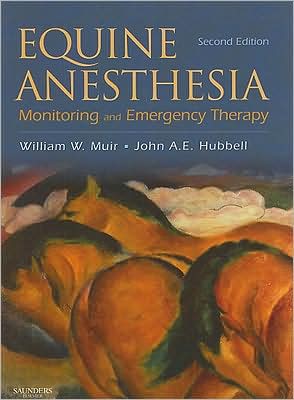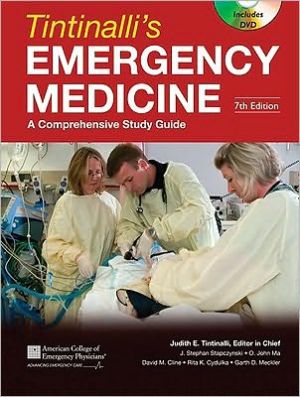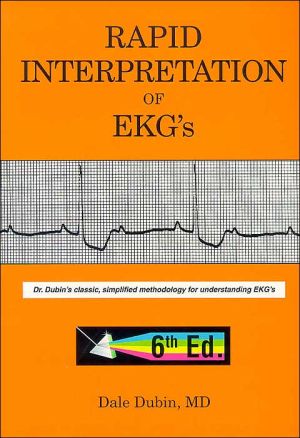Equine Anesthesia: Monitoring and Emergency Therapy
All veterinary team members involved in the everyday care of horses that require anesthesia or special emergency care will benefit from this reliable and inclusive resource. This text provides all of the information needed to prepare, conduct, and monitor the administration of drugs in order to produce safe and effective anesthesia, treat pain, respond to adverse effects, and perform and monitor emergency and critical care treatment. It is the most comprehensive and detailed book available on...
Search in google:
All veterinary team members involved in the everyday care of horses that require anesthesia or special emergency care will benefit from this reliable and inclusive resource. This text provides all of the information needed to prepare, conduct, and monitor the administration of drugs in order to produce safe and effective anesthesia, treat pain, respond to adverse effects, and perform and monitor emergency and critical care treatment. It is the most comprehensive and detailed book available on these subjects, addressing the needs and concerns of practitioners in both hospital and field settings.• Discusses all aspects of equine anesthesia, including history, physiology, pharmacology, drug dosages, patient preparation, induction-maintenance-recovery of anesthesia management of potential complications, and more. • Provides a detailed review of the respiratory and cardiovascular physiology of the horse. • Provides thorough coverage of preoperative pain management in horses. • Covers emergency medical care and managing anesthetic complications in both hospital and field situations. • Includes information on the latest anesthetic drugs, including safe and effective protocols for different procedures, and the most up-to-date monitoring techniques. • Each contributor is a recognized expert in his or her respective equine specialty, renowned for clinical as well as academic and research expertise.• A complete update of all drug information and pain management techniques. • The very latest research findings and clinical applications of anesthetic agents and techniques. • The most recent developments in post-anesthetic care and monitoring. • A chapter on intravenous anesthetic and analgesic adjuncts to inhalation anesthesia. • A chapter on anesthesia and analgesia for donkeys and mules. • A chapter on perioperative pain management. • Many new illustrations as well as tables, graphs, boxes, key points, and summaries that make information instantly accessible. Doody Review Services Reviewer:William M Karlin, BS, DVM(University of Illinois College of Veterinary Medicine)Description:This book covers a wide range of topics in equine anesthesia and goes into detail on specifics such as anesthesia protocols for certain types of surgery. This is a welcome update to the first edition of 1991.Purpose:The purpose is to provide a reference for equine anesthesia that can be understood by veterinarians and trained technicians.Audience:It is written for specialty veterinarians who deal with anesthesia, as well as for support staff. It could easily be used by students and residents as well.Features:This overview of equine anesthesia goes from start to finish including complications and other problems. It describes new procedures and methods in a very understandable way. The quick reference boxes are nice for a quick glance. The pictures would be better in color, and some of the graphs and charts are small and hard to read.Assessment:This well-written book gathers a lot of important information in one place. Veterinary Anesthesia and Analgesia, 3rd edition, McKelvey and Hollingshead (Elsevier, 2003) goes into more depth in general, but this book is specific to the horse, which is very nice.
Chapter 1: History of Equine AnesthesiaWilliam W. Muir IIIJohn A.E. HubbellChapter 2: The Respiratory SystemN. Edward RobinsonChapter 3: The Cardiovascular SystemColin C. SchwarzwaldJohn D. BonaguraWilliam W. Muir IIIChapter 4: Stress Associated with Anesthesia and SurgeryAnn E. WagnerChapter 5: Physical RestraintJames T. RobertsonWilliam W. Muir IIIChapter 6: Preoperative Evaluation: General ConsiderationsJames T. RobertsonClaire SciclunaChapter 7: Venous and Arterial Catheterization and Fluid TherapyJoanne HardyChapter 8: Monitoring AnesthesiaJohn A.E. HubbellWilliam W. Muir IIIChapter 9: Principles of Drug Disposition and Drug Interaction in HorsesRichard A. SamsWilliam W. Muir IIIChapter 10: Anxiolytics, Nonopioid Sedative-Analgesics, and Opioid AnalgesicsWilliam W. Muir IIIChapter 11: Local Anesthetic Drugs and TechniquesWilliam W. Muir IIIRoman T. SkardaChapter 12: Intravenous Anesthetic Drugs and Anesthetic TechniquesWilliam W. Muir IIIChapter 13: Intravenous Anesthetic and Analgesic Adjuncts to Inhalation Anesthesia Kazuto YamashitaWilliam W. Muir IIIChapter 14: Tracheal and Nasal IntubationRichard M. BednarskiChapter 15: Inhalation Anesthetics and GasesEugene P. SteffeyChapter 16: Anesthetic EquipmentRichard M. BednarskiChapter 17: Oxygen Supplementation and Ventilatory Support Carolyn L. KerrWayne N. McDonellChapter 18: Anesthesia and Analgesia for Donkeys and MulesNora S. MatthewsChapter 19: Peripheral Muscle RelaxantsJohn A.E. HubbellWilliam W. Muir IIIChapter 20: Perioperative Pain ManagementPhillip LercheWilliam W. Muir IIIChapter 21: Considerations for Induction, Maintenance, and Recovery from AnesthesiaJohn A.E. HubbellWilliam W. Muir IIIChapter 22: Anesthetic Associated ComplicationsWilliam W. Muir IIIJohn A.E. HubbellChapter 23: Cardiopulmonary ResuscitationWilliam W. Muir IIIJohn A.E. HubbellChapter 24: Anesthetic Protocols and Techniques for Specific ProceduresJohn A.E. HubbellWilliam W. Muir IIIChapter 25: Anesthetic Risk and EuthanasiaLori A BidwellJohn A.E. HubbellWilliam W. Muir IIIAppendicesRespiratory Abbreviations Used in the BookDrug SchedulesEquine Recovery SheetPain Management PlanAnesthesia Equipment Companies
\ Reviewer: W. Micahel Karlin, BS, DVM(University of Illinois College of Veterinary Medicine)\ Description: This book covers a wide range of topics in equine anesthesia and goes into detail on specifics such as anesthesia protocols for certain types of surgery. This is a welcome update to the first edition of 1991.\ Purpose: The purpose is to provide a reference for equine anesthesia that can be understood by veterinarians and trained technicians.\ Audience: It is written for specialty veterinarians who deal with anesthesia, as well as for support staff. It could easily be used by students and residents as well.\ Features: This overview of equine anesthesia goes from start to finish including complications and other problems. It describes new procedures and methods in a very understandable way. The quick reference boxes are nice for a quick glance. The pictures would be better in color, and some of the graphs and charts are small and hard to read.\ Assessment: This well-written book gathers a lot of important information in one place. Veterinary Anesthesia and Analgesia, 3rd edition, McKelvey and Hollingshead (Elsevier, 2003) goes into more depth in general, but this book is specific to the horse, which is very nice.\ \








